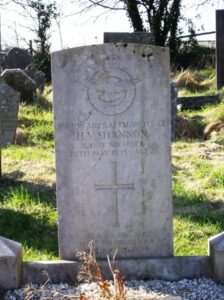The village of Letterston is sited near the West Pembrokeshire Coast, between St. Davids and Fishguard. The War Memorial in Letterston is sited in St. Giles’ Churchyard, and commemorates the men of the village who fell during both World Wars. These men are commemorated on this page. The war memorial from Trecwn Chapel has also been relocated next to the Letterston Memorial, as the Chapel has been sold and converted into a house. Please see the Trecwn War Memorial page for details of that.
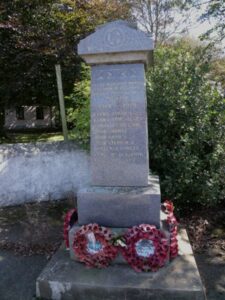
The Great War, 1914-1918
David John Evans, Gunner, W/829, Royal Field Artillery. David was the son of James and Rachel Evans, of Green Plain Cottage, Letterston. He enlisted at Bridgend into the 54th Battery, 39th Brigade, Royal Field Artillery. This was a regular Army Battery, attached to the 1st Division, and they had been in France since the retreat from Mons in August 1914. He was Killed in Action during the Battle of the Somme, on 13 August 1916, aged 22. David was buried in Quarry Cemetery, Montauban, France. His brother Samuel also fell.
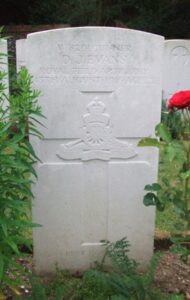
Samuel Henry Evans, Private, 25083, Welsh Regiment. Samuel was the son of James and Rachel Evans, of Green Plain Cottage, Letterston. The family later resided at Blonfair, West Street, Newport. He enlisted at Bridgend into the 15th Battalion, Welsh Regiment, which was known as the Carmarthen Pals battalion, attached to 114 Brigade, 38th (Welsh) Division. On 2 December 1915 the battalion moved to France, and the entire Division moved to the Fleurbaix sector, where it was initiated into trench warfare. During June 1916 the Division marched south to the Somme, and on 7 July 1916 attacked Mametz Wood. The initial attack failed, and it was three days later, on 10 July, that a fresh attack was mounted. After two days of heavy hand to hand fighting within the wood, the Germans withdrew, and the battered Welshmen moved via Hebuterne to Boesinghe, on the Yser Canal, where it remained until launching its attack on Pilckem Ridge on 31 July 1917. The 15th Welsh remained in the line, and also took part in the Battle of Langemarck, before the entire Division was moved to positions near Armentieres over the winter. After the Germans launched their offensive on the Somme on 21 March 1918, the Division was moved back to the Somme, and took up positions north of Albert, around Aveluy Wood. Samuel must have been taken Prisoner of War at some time, as he died in Germany of tuberculosis on 21 July 1918, aged 21. Samuel is buried in Cologne Southern Cemetery, Germany. His brother David also fell.
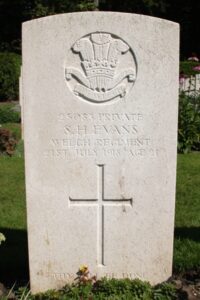
William Griffiths. Guardsman, 2141, Welsh Guards. William was born in St. Issell’s, the son of Benjamin and Rachel Griffiths. He worked as a miner prior to the war, and resided with his brother, John Griffiths, at Jeffreyston. William enlisted at Pembroke into the 1st Battalion of the Welsh Guards, part of 3rd Guards Brigade, Guards Division. The Welsh Guards were formed in France during August 1915, and were blooded at the Battle of Loos in September 1915. They moved to the Somme, and took part in the Battle of Flers-Courcelette. (where the famous photo of a Mark I tank rolling through the main street of Flers was taken; the first time a tank was ever used in Battle). William was Killed in Action on 10 September 1916, aged 27, and is buried at London Cemetery & Extension, Longueval, France.
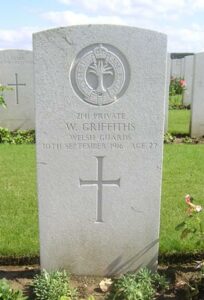
Harold Keith De Warenne Harvey, Lance Corporal, 84, Australian Imperial Force. Harold was born at Letterston, the son of Joshua Harold Harvey and Emily Jane Harvey. The family had residences at Marrick, Totland Bay, Isle of Wight and at Trevacoon, St. David’s. Harold had emigrated to Australia prior to the war, where he sought his fortune as a pearl fisherman, and enlisted at Broome, Western Australia, on 5 February 1915 into the Australian Imperial Force. Harold joined the 28th Battalion, AIF, which was attached to the 7th Australian Brigade, 2nd Australian Division. Harold then embarked at Fremantle on 12 July 1915 aboard the HMAT Ascanius, and sailed to Egypt, landing at Gallipoli on 4 September 1915. He was then attached to a Machine Gun unit at Gallipoli, and remained there until being evacuated in January 1916. On 21 March 1916 Harold landed at Marseilles, now back with the 28th Battalion, and they entrained for Northern France, taking the line near Bois Grenier. Harold was killed in action here during a routine spell in the trenches on 25 April 1916. He was 22 years old, and was buried at Ration Farm Military Cemetery, France, in Grave I. B. 10. His younger brother Ralph De Warenne Harvey also fell. Harold is not commemorated locally.
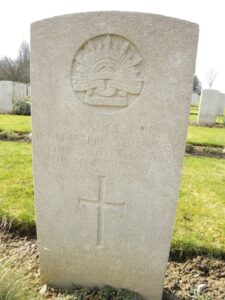
Ralph De Warenne Harvey, Second Lieutenant, Kings Royal Rifle Corps. Ralph was born at Letterston, the son of Joshua Harold Harvey and Emily Jane Harvey. The family had residences at Marrick, Totland Bay, Isle of Wight and at Trevacoon, St. David’s. Ralph was educated at Weymouth College, where he excelled at cricket, and was commissioned in January 1915 into the Dorsetshire Regiment. He was then posted to the 1st Battalion, King’s Royal Rifle Corps, which was in France attached to 99 Brigade, 2nd Division. The Division had been in France since the outbreak of war. In 1915 they took part in the Battle of Festubert, and in September fought at the Battle of Loos, and subsequent Action of Hohenzollern Redoubt. Ralph was seriously wounded at Loos, just as the Battalion was beginning its preparations for the move to the Somme, and died of his wounds on 7 June 1916, aged just 18. He is buried at St. Sever Cemetery, Rouen, France, in Grave Officers A. 2. 12. His elder brother Harold Keith De Warenne Harvey also fell. Ralph, like his brother, is not commemorated locally.
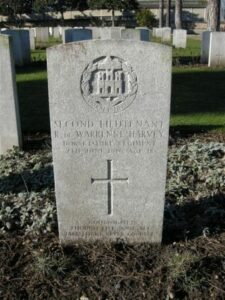
William Charles Henry Jeavons, Bombardier, 72383, Royal Garrison Artillery. William was born in Letterston, the son of Thomas John and Elizabeth Jeavons. The family later moved to Liverpool. William was a Railway Clerk prior to the war, and enlisted at Leicester into the Royal Garrison Artillery on 16 November 1915. William was posted to France on 21 September 1916, and joined the 60th Siege Battery, Royal Garrison Artillery. William served in France until 10 April 1917, when he was invalided to England with a carbuncle on his neck. William was sent to the Military Hospital at Glasgow, where his condition became worse, and he was diagnosed with leukaemia. William married Dorothy Hallam Loseby, a Red Cross Nurse, in hospital on 7 March 1918, and died just three days later, on 11 March 1918, aged 32. William is buried in Garston (St. Michael) Churchyard. William is not commemorated locally.
David James John, Private, 45356, Lancashire Fusiliers. David was the son of James and Susan John, of Midland, Letterston. He enlisted at Carmarthen into the 19th Battalion, Lancashire Fusiliers, who eventually became the Pioneer Battalion to the 49th (West Riding) Division. The Division were pushing the German’s back to the Selle River when David was Killed in Action on 13 October 1918, aged only 20. David is buried in Haspres Coppice Cemetery, Haspres, Northern France.
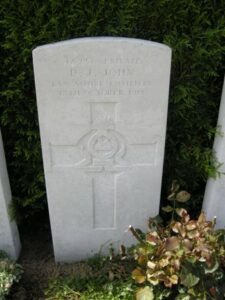
Stephen James John, Private, 54267, Welsh Regiment. Stephen was the son of John and Sophia John, of Yetyrhug, Letterston. He enlisted at Carmarthen into the 15th Battalion, Welsh Regiment, which formed part of 114 Brigade, 38th (Welsh) Division. The Division had suffered catastrophic losses on the Somme, at Mametz Wood, and weren’t used in action for another year, taking part in the Battle of Passchendaele, notably the Battle of Pilckem Ridge. The Division attacked the strongly fortified German positions North of Ypres, and despite the terrible conditions they succeeded in their objectives. Sadly Stephen was Killed in Action on 1 August 1917, aged 30. He has no known grave, and so is remembered on the Ypres (Menin Gate) Memorial, Belgium.
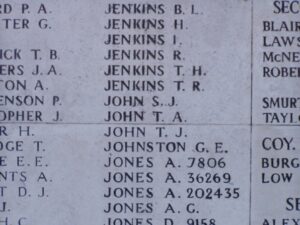
Thomas John, MM, Private, 22217, Welsh Regiment. Thomas was the son of James and Mary John, of Charles Court, Letterston. He enlisted at Maesteg into the 13th Battalion, Welsh Regiment, who were originally attached to 129 Brigade, 43rd Division, but on 28 April 1915 the formation became 114 Brigade, 38th (Welsh) Division. The Division were attacking toward the Hindenburg Line during the later stages of the war, pushing the German Army back around the Epehy area, when Thomas was Killed in Action on 8 October 1918. He was aged 26, and is buried in Unicorn Cemetery, Vend’huile, France. He had been awarded the Military Medal for Bravery in the Field during the war.
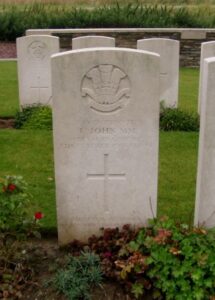
Evan Ernest Lawrence, Private, 10500, London Regiment (Artists Rifles). Ernest was the son of Thomas and Mary Lawrence, of Newport. He was a School Master at Hayscastle prior to the war, residing at Bryn Amlwg, Letterston. He married Florence Griffiths at Hill Park Baptist Chapel, Haverfordwest on 12 August 1913, and on 16 July 1915 Florence gave birth to their son, Thomas Emlyn Lawrence. Evan enlisted in London on 8 January 1917 into the 1/28th Battalion, the London Regiment (Artist’s Rifles), which formed part of the 63rd Royal Naval Division. The Artist’s Rifles were an elite Battalion, with many of their men being commissioned as Officers into other Battalions of the British Army. Ernest Died at the 1st London General Hospital of Septicaemia on 10 February 1917, and his body was brought home for burial at Letterston (Saron) Baptist Cemetery, to the right of the entrance.
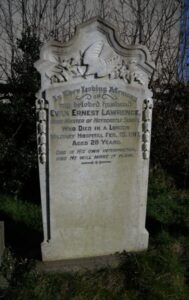
William Benjamin Lewis, Sergeant, G/25075, Duke of Cambridge’s Own (Middlesex) Regiment. William was the son of George and Mary Ann Lewis, of Prospect Place, Letterston. William enlisted at Letterston into the 13th Battalion, Middlesex Regiment, which formed part of 73 Brigade, 24th Division. The Division were in the St. Quentin sector when the German Offensive (Kaiserschlacht) began on 21 March, 1918. The British and Allied Armies mounted a desperate defensive action over the whole of the Western Front, with many units being totally annihilated by the German Stormtroopers. The first few weeks of the offensive were total chaos for the British, and William was Killed in Action on 28 March 1918, aged 37. His body was lost on the battlefield, and so William is remembered on the Pozieres Memorial, France.
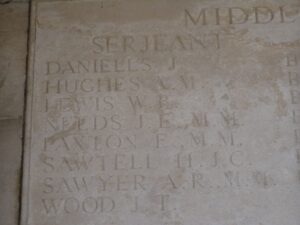
William Bowen Lewis, Private, 50106, Welsh Regiment. William was the son of David and Ann Lewis, of Bryn Awel, Letterston, and the brother of David Albert Lewis, of 9, Bridge Street, Cardigan. William was a schoolteacher prior to the war. He enlisted at Carmarthen into the 2nd Battalion, the Welsh Regiment, which formed part of 3 Brigade, 1st Division. This was a regular Army Division that had been in France since the Battle of Mons, and had fought through almost every major campaign of the Great War. The Division was in French Flanders during the middle of 1918, when they were still in the midst of the epic struggle to hold the German Offensive. William was Killed in Action on 6 June 1918, aged 36, and is buried in Sailly-Labourse Communal Cemetery Extension, France.
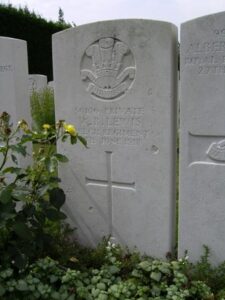
Francis John Lloyd, Gunner, 161161, Royal Garrison Artillery. Frank was the son of William and Elizabeth Lloyd, Letterston. His father died in 1894, and his mother married William Davies, of New Farm, St. Dogwell’s. Francis married Annie Thomas, of Llanelli in 1915. He enlisted at Llanelli into the 76th Siege Battery, Royal Garrison Artillery, and probably moved to France in 1916. Very little is presently known of his time at war, but Francis Died of Wounds on 20 September 1918, aged 24, and is buried in Sunken Road Cemetery, Boisleux-St-Marc, France.
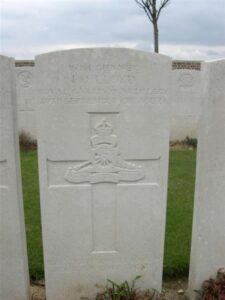
William George Mathias, Guardsman, 1210, Welsh Guards. William was born at Letterston, the son of John and Sarah Mathias. He resided in Fishguard prior to the outbreak of War, and enlisted at Bridgend into the 1st Battalion, Welsh Guards. The battalion had been formed after the Royal Warrant of 26 February 1915, and joined the 3rd Guards Brigade, Guards Division in France during the summer. They saw their first major action during the Battle of Loos in September 1915. William did not make it to France though, as he died at Caterham Military Hospital, Surrey on 20 May 1915, aged 30. He is buried in Fishguard (Hermon) Baptist Burial Ground. William is not commemorated at Letterston.
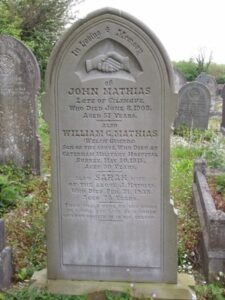
William Thomas Morris, Private, 25282, Welsh Regiment. William was born at Letterston, the son of Griffith and Emma Morris. After Griffith died, Emma became Mrs. James Gambold, of Charles Court, Letterston. William enlisted at Bridgend into the Welsh Regiment, but was transferred into 114 Company, Machine Gun Corps (Infantry), part of the 38th (Welsh) Division. William had survived Mametz, but was Killed in Action just prior to the Battle of Pilckem, on 4 June 1917. He is buried in Essex Farm Cemetery, Belgium.
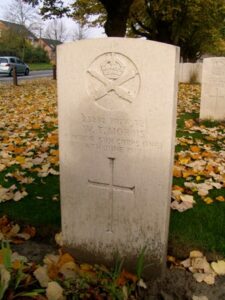
David John Richards, Driver, 25259, Royal Field Artillery. David was born at Letterston in 1883, the son of Daniel and Mary Anne Richards. He enlisted into the Royal Field Artillery in 1902 and married Eleanor Thomas, of 6, Edgware Road, Uplands, Swansea, on 20 November 1907. David was an army reservist at the outbreak of war, after having retired in June 1914 after twelve years with the colours. Upon the outbreak of war, David rejoined the Royal Field Artillery at Cardiff, and was posted to France with 115 Battery, Royal Field Artillery. The Battery was present at the retreat from Mons in August, 1914, and it was sometime during this epic fighting withdrawal that David was wounded in action. He was transported to the Military Hospital at Boulogne, where he died of wounds on 15 November 1914, aged 31. David is buried at Boulogne Eastern Cemetery, France.
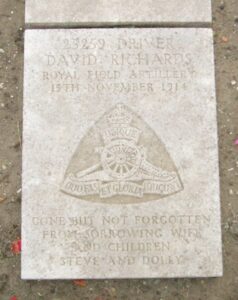
Thomas Henry Thomas, MM, Private, T/F/291824, Middlesex Regiment. Thomas was born at Letterston, the son of Ann Thomas. He worked in London as a Dairyman prior to the war, and enlisted at Marylebone on 30 August 1914, into the 2/10th Battalion, the Middlesex Regiment. They formed part of the Welsh Border (160) Brigade, 53rd (Welsh) Division. The 53rd Division landed on Gallipoli on 9 August 1915, and after suffering terrible losses on the Peninsula, were moved to Egypt. There, they fought in Palestine, capturing the Holy City of Jerusalem between 7 and 9 December 1917. Thomas was Killed in Action on 12 December 1917, and is buried in Jerusalem War Cemetery, Israel. Thomas was awarded the Military Medal, for bravery in the field, on 19 August 1917.
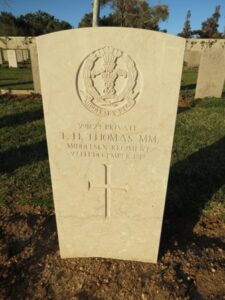
Walter Price Williams, Private, 201599, Welsh Regiment. Walter was born on 25 April 1895, the son of Owen and Mary Williams, of 4, Caeraw, Llanrhian. He resided in Letterston prior to enlisting at St. David’s into the Welsh Regiment. Walter was probably posted to France early in 1917, and joined the 14th Battalion, Welsh Regiment, which was attached to 114 Brigade, 38th (Welsh) Division. The battalion was at Ypres, positioned at Boesinghe, along the Yser Canal. On 31 July 1917 the division made its famous successful assault on Pilckem Ridge, moving the front line forwards to the Steenbeek. Walter was killed in action at Langemarck on 5 August 1917, aged 23. He is buried in Welsh Cemetery (Caesar’s Nose), Belgium.
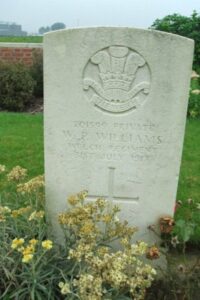
World War Two, 1939-1945
William Hubert Harries, Gunner, 14206517, Royal Artillery. William was the son of William and Elizabeth Harries, of Letterston and the husband of Helen Harries, of Kilmarnock, Ayrshire. He served in the 145 (Berkshire Yeomanry) Field Company, Royal Artillery. The unit landed in India during February 1945, before moving to Malaya as part of OP ZIPPER in September 1945. In December the Regiment deployed to Java to help re-establish the Dutch colony there, and saw heavy fighting against Indonesian nationalists. The Regiment arrived at Sourabaya in the afternoon of 3 December 1945, and began unloading their ship. William slipped into the strong running water whilst unloading the ship, and although a Gunner Allcock dived in to try and rescue him, he was swept away and drowned. William was 22 years old, and is remembered on the Singapore Memorial. (Many thanks to Andrew French, Curator of the Berkshire Yeomanry Museum, for the information).
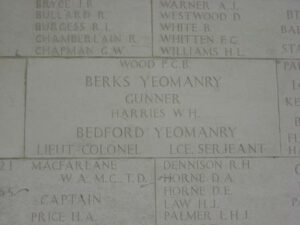
Thomas James, Driver, T/251529, Royal Army Service Corps. Thomas was the son of John and Mary James of Letterston, and the Husband of Irene James of Letterston. Sadly nothing much is known of him, except that he served with 235 Corps Company, Royal Army Service Corps, and died, aged 32, on 7 January 1943. Thomas is remembered on the Brookwood Memorial, Surrey.
Phillip John Jenkins, Guardsman, 2740444, Welsh Guards. Phillip was the son of James and Martha Jenkins, of Letterston. Very little is known of him, but he served with the Welsh Guards, and died, aged 19, on 3 January 1947. He is commemorated by the CWGC, and so his death must have been as a result of the war. Phillip is buried at Letterston (St. Giles) Churchyard, but is not commemorated on the Letterston War Memorial.
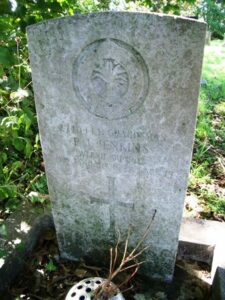
Thomas Vivian Lawrence, Leading Aircraftman, 1115769, Royal Air Force Volunteer Reserve. Thomas was the son of James and Elizabeth Ann Lawrence, and the Stepson of Mrs. E. Lawrence, of Letterston. He served with the Royal Air Force Volunteer Reserve, and died on active service at Sleaford, Lincolnshire on 12 May 1943, aged 32. Thomas is buried in Letterston (St. Giles) Churchyard.
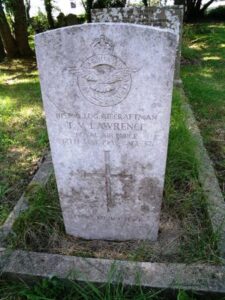
Charles Norman Lewis, Flight Sergeant, 517386, Royal Air Force. Charles was the son of Arnold H. Lewis and Emma Alice Lewis, of Letterston. He served with 228 Squadron, Royal Air Force, which was in Egypt at the outbreak of WW2 flying the Short Sunderland, and returned home immediately, to Pembroke Dock. In June, 1940 the Squadron returned to Egypt, and in June, 1941 spent several months in Gambia before returning again to Pembroke Dock in August, where he served on the Short Sunderland ‘Flying Boats’. On 25 August 1942, Charles was a crewman aboard a Sunderland which took off from Invergordon, bound for Iceland, carrying among its passengers HRH the Duke of Kent. Mysteriously the Sunderland crashed into Eagle’s Rock, Scotland, and exploded, killing fifteen passengers and crew, with only the tail gunner surviving. Charles was 27 years old when he died that day, and was brought home for burial at Letterston (St. Giles) Churchyard.
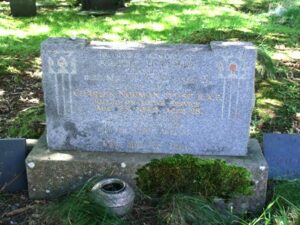
Willie George Morris, Gunner, 3914439, Royal Artillery. Willie was the son of John and Elizabeth Morris of Letterston. He served with 108 Heavy Anti Aircraft Battery, Royal Artillery, which was stationed in the Shetland Isles, guarding the two RAF Stations there. Willie died on Shetland on 22 January 1942 aged 27, and is buried at Fair Isle Cemetery, Dunrossness, Scotland.
Albert James Phillips. Albert lived at The Harp, Letterston. He is not commemorated on the Letterston War Memorial, but he is buried at St. Giles Churchyard, and his headstone states that he died as a result of war wounds on 11 December 1952. He was 53 years old.
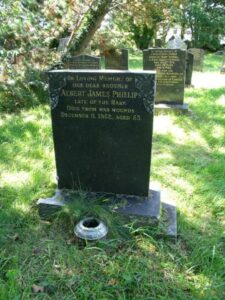
Thomas Phillips. This probably relates to the Civilian Thomas Phillips, who was born in Llanrhian around 1896. Thomas was drinking at the Prince Albert Inn, Melville Street, Pembroke Dock, when the Luftwaffe bombed the Dockyard on 12 May 1941. Thomas was killed in the air raid that day, aged 46.
Henry Victor Shannon, Aircraftman 1st Class, 1196209, Royal Air Force Volunteer Reserve. Henry was born at Devonport in 1918, the son of Joseph Henry and Frances Alice Shannon. His father was a Royal Naval seaman and after retiring moved the family to Letterston. Henry joined the Royal Air Force Volunteer Reserve, and was posted to 20 Squadron, RAF. The squadron had been based in India during the war, equipped with the Lysander and Hawker Hurricane. Henry must have been invalided home at some time and died at Haverfordwest on 20 May 1945 aged 26. He is buried at Llanfair Nant-Y-Gof (St. Mary) Churchyard. Henry does not seem to be commemorated on any local war memorial.
